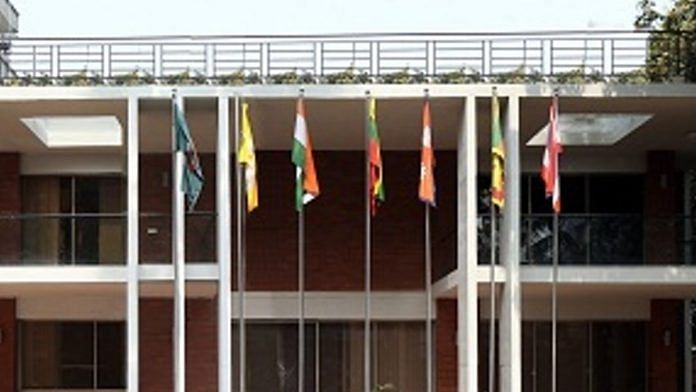New Delhi: Quick on the heels of the first Quad summit, India will be a part of the Bay of Bengal Initiative for Multi-Sectoral Technical and Economic Cooperation (BIMSTEC)’s 17th meeting scheduled virtually on 1 April.
Intra-regional trade amid the pandemic, technology, innovation and finalising the BIMSTEC free trade agreement is likely to be on the agenda, nearly two years after the body’s last meet in Kathmandu.
Headquartered in Dhaka, BIMSTEC is an inter-regional grouping that seeks to foster regional and economic cooperation among nations in the littoral and adjacent areas of the Bay of Bengal — India, Thailand, Myanmar, Nepal, Bangladesh, Sri Lanka and Bhutan.
The BIMSTEC region is home to roughly 22 per cent of the global population with a combined GDP of over $2.7 trillion.
Due to setbacks to the South Asian Association of Regional Cooperation (SAARC), particularly when its 2016 summit scheduled to be held in Pakistan was suspended after member countries declined to participate, BIMSTEC has emerged as the “preferred platform” for regional cooperation in South Asia.
In June 2019, shortly after he took charge as Foreign Minister S. Jaishankar remarked that SAARC has “issues” and therefore, India would look towards BIMSTEC as a priority over the next five years. What was also significant was the presence of BIMSTEC leaders at Prime Minister Narendra Modi’s swearing-in ceremony earlier that year — and the absence of Pakistan PM Imran Khan, who wasn’t extended an invite.
However, BIMSTEC has come under scrutiny for failing to achieve milestones within 23 years of its inception. Experts have also criticised the body’s inadequate response towards issues like the Rohingya crisis which involves three of its member countries — Myanmar, India and Bangladesh.
Ahead of the body’s meet, here’s a look at BIMSTEC’s formation, its significance and criticism directed towards it.
Also read: India, Bangladesh likely to sign 3 MoUs during PM Modi’s Dhaka visit
BIMSTEC formation & relevance in Indo-Pacific region
BIMSTEC is an economic bloc that came into being on 6 June 1997 through the Bangkok Declaration. It aims to accelerate economic growth and social progress among members across multiple sectors — trade, technology, energy, transport, tourism and fisheries, agriculture, public health, poverty alleviation, counter-terrorism, environment, culture, people to people contact and climate change.
The grouping holds annual meetings hosted by member states based on alphabetical rotation. Sri Lanka is the host nation this time.
Initially, the economic bloc was formed with four countries with the acronym ‘BIST-EC’ (Bangladesh, India, Sri Lanka and Thailand Economic Cooperation). With the entrance of Myanmar in 1997, the grouping was renamed ‘BIMST-EC’ (Bangladesh, India, Myanmar, Sri Lanka and Thailand Economic Cooperation).
Finally, with the entrance of Nepal and Bhutan at the 6th Ministerial Meeting in 2004, the grouping was named Bay of Bengal Initiative for Multi-Sectoral Technical and Economic Cooperation (BIMSTEC).
Some key agreements signed by BIMSTEC members include a convention for combating terrorism, transnational organised crime and illicit drug trafficking. However, this awaits ratification.
Another is the BIMSTEC Grid Interconnection, signed during the BIMSTEC Summit in Kathmandu, Nepal, in 2018, which aims to promote an optimal power transmission in the BIMSTEC region.
In the mid-2010s, BIMSTEC gained attention as India-Pakistan tensions began to hamstrung SAARC.
In a television debate, senior journalist K.V. Prasad had explained, “Back in 2014, when SAARC was held in Kathmandu — the last SAARC summit — PM Modi made an emphatic statement that all members of SAARC need to come together, especially on infrastructure and connectivity. One punchline was — ‘Those who want to come with us, welcome and those who do not, the rest of us will continue’.”
Later in 2016, India held a joint BRICS-BIMSTEC Summit in Goa for the latter’s regional outreach. After this, the support for BIMSTEC gained further momentum.
The Bay of Bengal has grown in strategic significance within the Indo-Pacific, especially due to the contest between India and China.
What was once a region bereft of any major conflicts is now poised to become “a zone of geopolitical rivalry among major powers and of regional conflict”, wrote Dr C. Raja Mohan, director of the Institute of South Asian Studies, National University of Singapore in a paper for the Observer Research Foundation last October.
Also read: India’s engagement with China complex, Union minister Muraleedharan tells Lok Sabha
Dormancy, stalled FTA process & other drawbacks
BIMSTEC has come under scrutiny mainly due to dormancy in initial years and a stalled FTA process. The fact that other countries in the Bay of Bengal like Malaysia, Singapore and Indonesia have not been involved even as dialogue partners has also been a point of contention.
On the issue of dormancy, BIMSTEC didn’t have an official head office and meetings were held at the Thai foreign ministry in Bangkok until it was given headquarters in Dhaka in 2011 and a secretary general, Sri Lankan diplomat Sumith Nakandala, in 2014.
In 2018, India aggressively pushed for the conclusion of a long-pending FTA among BIMSTEC nations but differences between India and Thailand over market access for professionals, duty cuts on traded goods and policy relaxation stalled the process.
Asked about this sluggish performance, Prabir De, professor and coordinator of ASEAN-India Centre, Research and Information System for Developing Countries, told ThePrint, “The reason small nations in the Bay of Bengal, Indian Ocean and Pacific Ocean are turning to regional blocs like BIMSTEC is because they gain higher economic dividends from regional blocks than fragmented multilateralism promoted by the World Trade Organization (WTO).”
He added, “BIMSTEC has been slow on the come-up because unlike bodies like the EU or ASEAN, it is based on consensus-building which takes time.”
He said the regional body is progressing well mainly because member countries do not have major border disputes. “Any small scuffles, like the Nepal-India map row, can be resolved bilaterally,” he added.
Also read: PM Modi, Portuguese counterpart review preparations for first ever India-EU leaders’ meet



